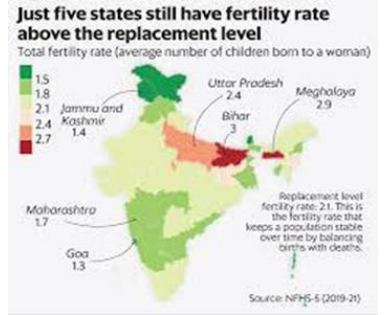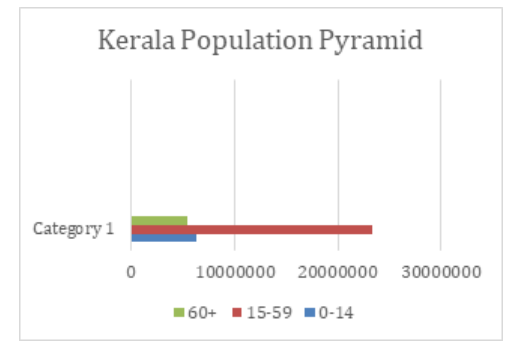
The decline in Total Fertility Rate (TFR) below the replacement level in numerous states of India could profoundly shape the future population structure of the country. The Total Fertility Rate represents the average number of children born to a woman during her reproductive years, and a drop below the replacement level implies that, on average, each woman is having fewer than two children. This demographic shift can have far-reaching consequences on the age distribution, workforce dynamics, and overall societal composition of India. As the country grapples with the complexities arising from a diminishing TFR, understanding the potential impacts on population structure becomes essential for policymakers, planners, and the broader society to navigate the challenges and opportunities associated with this demographic transition.
Contents
Answer
India’s TFR has fallen below the replacement level of 2.1, population is no longer growing at a sustainable rate. There is significant variation in TFR across states in India. For example, the TFR in Bihar (3.0) is more than twice the TFR in Kerala (1.8), which would affect the future population structure of the country in significant ways.


Impact of declining TFR below replacement level on future population structure of the country
- A TFR below the replacement level indicates that many states in India are moving toward the later stages of demographic transition, where birth rates decline and population growth stabilizes
- For e.g., Kerala with TFR 1.6 to 1.7 is in later stages of demographic transition implying high socio-economic development and stable population growth.
- A lower TFR results in a higher proportion of elderly individuals relative to the working-age population.
- This creates various challenges-demand for healthcare services, social services, and pensions.
- For e.g., TFR in Tamil Nadu is 1.76 and the average age of the Tamil Nadu population is 37.2 years, slightly higher than the national average of 28.2 years (Sample Registration System-2023)
- A declining TFR would result in a lower dependency ratio as there are relatively more people in the working-age group to support dependents.
- For e.g., TFR in Karnataka is 1.7 and Dependency ratio in Karnataka in 2023 is 46.0 which is less than national average of 59.4
- A declining TFR means fewer young people entering the labour force, can have a detrimental effect on economic growth and labour market dynamics.
- For e.g., The Labour Force Participation Rate (LFPR) in Kerala is 55.2% as of 2021-22. This is slightly lower than the national average LFPR of 58.4%
- Over time, the population pyramid will begin to invert, meaning that the top of the pyramid (the elderly population) will become larger than the base (the young population).
- For e.g. The population pyramid of Kerala is already inverting, with the elderly population becoming larger than the young population.

A declining TFR below the replacement level in many states of India represents a shift toward demographic stability and an aging population. Understanding these changes is crucial for policymakers as they plan for the future and consider strategies to address the evolving needs of the population.
In case you still have your doubts, contact us on 9811333901.
For UPSC Prelims Resources, Click here
For Daily Updates and Study Material:
Join our Telegram Channel – Edukemy for IAS
- 1. Learn through Videos – here
- 2. Be Exam Ready by Practicing Daily MCQs – here
- 3. Daily Newsletter – Get all your Current Affairs Covered – here
- 4. Mains Answer Writing Practice – here

